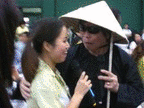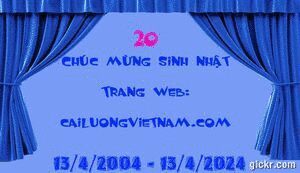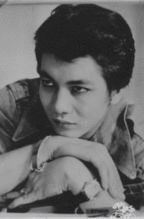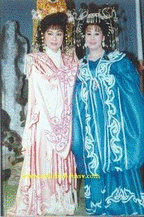•Menu
•Tin đọc nhiều
- NSND Thanh Điền tới lễ trao danh hiệu nghệ sĩ và nhận cùng lúc 2 tấm bằng danh hiệu NSND. Một cho ông, một cho người vợ quá cố Thanh Kim Huệ.
-
 Hành trình 20 năm - Một trang web để đời
Hành trình 20 năm - Một trang web để đời
-
 Ngôi sao của vở cải lương kinh điển 'Bên cầu dệt lụa' đi xe ôm, bán bảo hiểm
Ngôi sao của vở cải lương kinh điển 'Bên cầu dệt lụa' đi xe ôm, bán bảo hiểm
-
 Vở cải lương kinh điển Khách sạn hào hoa quảng bá cho giải Trần Hữu Trang
Vở cải lương kinh điển Khách sạn hào hoa quảng bá cho giải Trần Hữu Trang
-
 Vinh danh NSND Kim Cương
Vinh danh NSND Kim Cương
-
 Thúy Nga tạm dừng nghệ thuật
Thúy Nga tạm dừng nghệ thuật
-
 Gặp lại nghệ sĩ Kiều Phượng Loan, vì sao từ chối chức trưởng đoàn kịch?
Gặp lại nghệ sĩ Kiều Phượng Loan, vì sao từ chối chức trưởng đoàn kịch?
-
 5 HCV, 7 HCB được trao tại cuộc thi cải lương “Mộc Quán - Nguyễn Trọng Quyền”
5 HCV, 7 HCB được trao tại cuộc thi cải lương “Mộc Quán - Nguyễn Trọng Quyền”
-
 Nghệ sĩ Tú Trinh: Tôi sợ lặp lại chính mình
Nghệ sĩ Tú Trinh: Tôi sợ lặp lại chính mình
-
 Vở cải lương sử Việt "Ngược dòng Tây Sơn": Nêu cao tinh thần ái quốc
Vở cải lương sử Việt "Ngược dòng Tây Sơn": Nêu cao tinh thần ái quốc
•Tin ngẫu nhiên
-
 Cách đãi cát tìm vàng hay của bầu Hương Sỹ Nhân
Cách đãi cát tìm vàng hay của bầu Hương Sỹ Nhân
-
 Minh Hằng: Phải diễn sao cho xứng đáng với tác phẩm của Vũ Trọng Phụng
Minh Hằng: Phải diễn sao cho xứng đáng với tác phẩm của Vũ Trọng Phụng
-
 NS Thu Vân - Đồng Vọng Tiếng Chuông Vàng
NS Thu Vân - Đồng Vọng Tiếng Chuông Vàng
-
 Ca sĩ Thanh Tuyền: "Tôi không có số yêu nghệ sĩ nên không yêu Chế Linh"
Ca sĩ Thanh Tuyền: "Tôi không có số yêu nghệ sĩ nên không yêu Chế Linh"
-
 Điều kỳ diệu của bài vọng cổ
Điều kỳ diệu của bài vọng cổ
-
 Cải lương- Bụng Đói Đi làm từ thiện
Cải lương- Bụng Đói Đi làm từ thiện
-
 MINH THUẬN HẠNH PHÚC GẶP LẠI NGƯỜI XƯA
MINH THUẬN HẠNH PHÚC GẶP LẠI NGƯỜI XƯA
-
 Chàng trai 9X mê đờn ca tài tử
Chàng trai 9X mê đờn ca tài tử
-
 MC Đức Tiến và Hoa hậu...
MC Đức Tiến và Hoa hậu...
-
 Vua Phật - bản hùng ca hun đúc ý chí tự lực, tự cường
Vua Phật - bản hùng ca hun đúc ý chí tự lực, tự cường
•Thống kê truy cập
![]() Đang truy cập :
162
Đang truy cập :
162
•Máy chủ tìm kiếm : 2
•Khách viếng thăm : 160
![]() Hôm nay :
20391
Hôm nay :
20391
![]() Tháng hiện tại
: 2195109
Tháng hiện tại
: 2195109
![]() Tổng lượt truy cập : 88501710
Tổng lượt truy cập : 88501710
 »
Tin Tức
»
English
»
Tin Tức
»
English

Thí sinh Lê Hoàng Nghi đoạt giải Chuông vàng vọng cổ lần thứ 19 – năm 2024
Tối 29-9, vòng chung kết xếp hạng cuộc thi "Chuông vàng vọng cổ" 2024 đã diễn ra với phần tranh tài của 3 thí sinh là: Dương Thị Mỹ Nhung, Nguyễn Hùng Vương, Lê Hoàng Nghi tại Nhà hát Truyền hình HTV.
Vọng Cổ : Sáu Câu (Six Phrases)
Đăng lúc: Thứ tư - 18/06/2014 08:05 - Đã xem: 4882
Út Bạch Lan & Minh Cảnh in " Con Gái Chị Hằng"
Modern vọng cổ is made up of six phrases of thirty-two measures. A noticeable cadence ends each sub-phrase of four measures. At this cadence, all instruments (and the vocalist) come back together, usually hitting the same note. At eight measures before the end of a phrase, the song loan is tapped twice consecutively by the leader (usually the đàn kìm player) to signify that the phrase is ending. On the last measure of a phrase, the song loan is tapped once more to make sure everyone ends together. At that point, the performers may move on to the next phrase, transition to a different song, or end completely.
Câu Một Vọng Cổ (Vọng Cổ: Phrase One)
The first phrase of vọng cổ always begins with a rao, an improvised introduction
by all the musicians. If there is a vocalist, the music fades away and then he
begins singing the first line of text with no accompaniment. This vocal line,
also part of the rao, is improvised in both melody and rhythm. The next-to-last
note is typically drawn out for a very long time before the singer cadences on
Hò and all musicians join him. This first declaration is considered the
"crowd-pleaser," and well-performed renditions are always met with applause as
soon as the cadence hits.
Because of the rao, the first phrase is shortened to only sixteen measures, with
cadences as follows:
Hò --- --- Hò
--- --- --- (+) Xê
--- --- --- Xang
--- --- --- (+) Cống
(+) denotes a song loan clap
The first Hò at the beginning of the table represents the last cadence of the
rao introduction. Measures with dashes through them represent free improvisation
(within the constraints of the hơi until the cadence.
From câu một, one always transitions to another phrase.
Câu Hai Vọng Cổ (Vọng Cổ: Phrase Two)
--- --- --- Xê
--- --- --- Xang
--- --- --- Xang
--- --- --- Hò
--- --- --- Hò
--- --- --- (+) Xê
--- --- --- Xê or Xang
--- --- --- (+) Xang
(+) denotes a song loan clap
The second phrase can be used as a passing phrase, especially in the "one, two,
three" pattern, or it can be used as a closing phrase, with the final cadence on
Xang adding an emotional charge suitable for laments and grief-laden drama. The
preceding cadence floats between xê and xang, although xê might be used to
soften the transition to Xang at the end.
Câu Ba Vọng Cổ (Vọng Cổ: Phrase Three)
--- --- --- Xê
--- --- --- Xang
--- --- --- Xang
--- --- --- Xê
--- --- --- Xang
--- --- --- (+) Cống
--- --- --- Xê
--- --- --- (+) Hò
(+) denotes a song loan clap
Câu ba (phrase three) usually appears as a transition from câu hai (phrase two).
It works well as a closing phrase, because it ends on Hò (tonic). For the same
reason, one rarely continues directly from this phrase to another one; instead,
musicians may transition to another song, perform another rao, then finish the
vọng cổ cycle with "four -> five -> six" or "five -> six".
Câu Bốn Vọng Cổ (Vọng Cổ: Phrase Four)
--- --- --- Hò
--- --- --- Xề
--- --- --- Xề
--- --- --- Xê
--- --- --- Xang
--- --- --- (+) Cống
--- --- --- Xang or Xê
--- --- --- (+) Hò
(+) denotes a song loan clap
The notable aspect of this phrase is to distinguish between Xê, with circumflex
only, and Xề, with circumflex and grave (see diacritics for details). Xê
represents the pitch above Hò shown previously, while Xề represents one octave
below that note. Both are used in this phrase as cadences.
Câu bốn is occasionally used as the opening phrase in a vọng cổ performance. In
this case, it is truncated to sixteen measures (the last four cadences) and then
merged with câu một (details below in "Phrase Order"). The new phrase, which is
treated just like câu một, becomes:
--- --- --- Hò
--- --- --- (+) Xê
--- --- --- Xê
--- --- --- (+) Hò
(+) denotes a song loan clap
Câu Năm Vọng Cổ (Vọng Cổ: Phrase Five)
--- --- --- Xê
--- --- --- Hò
--- --- --- Hò
--- --- --- Hò
--- --- --- Hò
--- --- --- (+) Xê
--- --- --- Xang or Xê
--- --- --- (+) Xề
(+) denotes a song loan clap
Câu Năm is typically not recognized throughout by its melodic nature, but by its
rhythm. While other phrases show stresses on the beat, this phrase begins with
syncopated stresses and novel rhythms. It also boasts the most unique ending
cadence, on the pitch Xề in the low register. This closing cadence is often
referred to as "xuống xề" (going down to the xề pitch).
This phrase typically continues to câu sáu, because xề does not have the melodic
finality of xang or hò.
Câu Sáu Vọng Cổ (Vọng Cổ: Phrase Six)
--- --- --- Xề
--- --- --- Xê
--- --- --- Xang
--- --- --- Cống
--- --- --- Xê
--- --- --- (+) Xề
--- --- --- Xê
--- --- --- (+) Hò
(+) denotes a song loan clap
The use of xê and xề continuously can be seen as strengthening the return to hò
in similar fashion to the use of the "dominant" (fifth) in classical western
music. The finality of this phrase is always evident during performance.
Phrase Order
The phrases can be played in order, but this is not always the case. Popular
combinations of phrases include:
one, two, three
one, two, three, break, four, five six
one, two, break, five, six
one, five, six
Other combinations are possible, but these patterns represent the majority of
cases. The break in some patterns represent a transition to some other piece.
Possibilities include ngâm thơ (poetry declamation, tân nhạc (modern popular
music), nhạc cổ (traditional music), dân ca (folk songs), or even another rao
(improvised introduction).
When one starts with a phrase other than câu một, it''s necessary to merge the
two phrases (the new phrase and câu một to make a new opening phrase that is
both recognizeable and cohesive. First, one can remove the first sixteen
measures, cutting the phrase to sixteen measures like câu một (phrase one). This
leaves the necessary space for the rao. Afterwards, the phrases are merged, so
that the first eight measures are exactly the same as câu một and the last eight
measures are the last eight measures of the other phrase. This was how the
diagram for câu bốn (phrase four) above was prepared. Because the first, fourth,
and fifth phrases are the phrases used most as the starting phrase after the rao,
this technique is typically only used for the fourth and fifth phrases.
Famous Songs Based on Vọng Cổ
As has been stressed above, vọng cổ has more to do with a system of music than
any particular song. No two performances of vọng cổ music will ever be the same,
and futhermore, writers have penned many different verses to be used in vọng cổ
for many different performers and plays.
Some of the most renowned vọng cổ pieces have come from the prolific composer
Viễn Châu. Some of his famous verses include the lament by Võ Đông Sơ for his
lover Bạch Thu Hà in the play Võ Đông Sơ Bạch Thu Hà( sung by Minh Cảnh) and the
lament by Lan as she becomes a Buddhist nun in the play Lan và Điệp (sung by Út
Bạch Lan).
Nguồn tin: VNM
Những tin mới hơn
- Actress Thanh Thanh Hoa – The Gold Medalist of the Prestigious Thanh Tam Award in 1961 (15/08/2014)
- Actress Thanh Thanh Hoa – The Gold Medalist of the Prestigious Thanh Tam Award in 1961 (19/08/2014)
- Trieu Trung Kien (29/08/2014)
- Memories (07/09/2014)
- The meaning & history of SaiGon - Ý nghĩa và lịch sử Sài Gòn (29/07/2014)
- Early days in Le Thuy’s performing career (23/07/2014)
- Sixty Zitherists perform in HCMC (03/07/2014)
- THE SURVIVAL OF THE TRADITIONAL MUSIC (NHAC CO TRUYEN) (05/07/2014)
- Actress Bich Hanh’s biography and memories (12/07/2014)
- Actor Viet Hung (28/06/2014)
Những tin cũ hơn
- Actress UT BACH LAN – An Artist’s Life is Like a Short-lived Flower (11/06/2014)
- Bach Tuyet, A Precious Gem of Cai luong (06/06/2014)
- HISTORY OF VIETNAMESE MUSIC (03/06/2014)
- Cai luong legend comes to life in photos (29/05/2014)
- Vietnam has full Vietnam has full foundation on sovereignty over Hoang Sa, Truong Sa (27/05/2014)
- Ex-ethnic beauty queen says victory made her miserable (25/05/2014)
- Vietnam provinces pledge support foreign investors after riots (18/05/2014)
- Op-Ed: The greatest Mother’s Day gift (10/05/2014)
- Traditional Vietnamese music festival kicks off in Bac Lieu (23/04/2014)
- Sad life stories of “Đờn ca tài tử” elite stars (01/04/2014)
Mã an toàn: ![]()
•CHUYỂN ĐẾN WEBSITE...
•Tin mới nhất
-
 Thí sinh Lê Hoàng Nghi đoạt giải Chuông vàng vọng cổ lần thứ 19 – năm 2024
Thí sinh Lê Hoàng Nghi đoạt giải Chuông vàng vọng cổ lần thứ 19 – năm 2024
- Giữ bản sắc cho cải lương tuồng cổ
-
 “Đêm huyền thoại” quy tụ nhiều ngôi sao sân khấu cải lương
“Đêm huyền thoại” quy tụ nhiều ngôi sao sân khấu cải lương
-
 Tâm Sự Thần Y 4.0
Tâm Sự Thần Y 4.0
-
 Thông diệp của cải lương điện ảnh
Thông diệp của cải lương điện ảnh
-
 NSND Thanh Nam và nghệ sĩ Chí Tâm ngồi ghế nóng "Chuông vàng vọng cổ" lần thứ 19 - 2024
NSND Thanh Nam và nghệ sĩ Chí Tâm ngồi ghế nóng "Chuông vàng vọng cổ" lần thứ 19 - 2024
-
 Nhiều người trẻ tâm huyết với nghệ thuật hát bội
Nhiều người trẻ tâm huyết với nghệ thuật hát bội
-
 Nghệ sĩ Bích Thuận qua đời
Nghệ sĩ Bích Thuận qua đời
-
 Vở "Sấm vang dòng Như Nguyệt" - dấu ấn mới của NSƯT Chí Linh, Vân Hà
Vở "Sấm vang dòng Như Nguyệt" - dấu ấn mới của NSƯT Chí Linh, Vân Hà
-
 Trà Vinh vận động gây quỹ xây dựng Khu Lưu niệm NSND Viễn Châu
Trà Vinh vận động gây quỹ xây dựng Khu Lưu niệm NSND Viễn Châu
•Đăng nhập thành viên
- Những Vở Diễn Hay KIỆT TÁC SÂN KHẤU THẾ GIỚI: LÔI VŨ
- Nghệ Sĩ Tâm Sự Ngọc Huyền 'vẫn bị cấm hát tại Việt Nam'
- Đời Thường Nghệ Sĩ Con dâu trẻ của NSUT Thoại Miêu qua đời chưa đầy 2 năm cưới
- Đời Thường Nghệ Sĩ Nghệ sĩ Tú Sương kết hôn với Việt kiều
- Tâm Tư Thành Viên Người trong giới tự nói gì về nghệ sĩ Mỹ Châu ?
- Trong bầu trời nghệ thuật sân khấu cải lương, nghệ sĩ Thành Được mãi là ngôi sao sáng vĩ đại. Ông đã...
- Tôi cũng biết một soạn giả có tên YÊN BA, nhưng tên thật là PHẠM DIỆP PHƯƠNG, là quân y, KBC 7019
- Bài viết khá đầy đủ về cuộc đời của thầy Văn Hải. Có vài lỗi chính tả không nên có
- thag điên nai ma diên cai gi . toan bac chuoc nsut thanh nam . bat chuoc kieu ngu
- Tôi rất mong chờ để được xem cải lương nhưng thật thất vọng.

Thí sinh Lê Hoàng Nghi đoạt giải Chuông vàng vọng cổ lần thứ 19 – năm 2024
Tối 29-9, vòng chung kết xếp hạng cuộc thi "Chuông vàng vọng cổ" 2024 đã diễn ra với phần tranh tài của 3 thí sinh là: Dương Thị Mỹ Nhung, Nguyễn Hùng Vương, Lê Hoàng Nghi tại Nhà hát Truyền hình HTV.






































Ý kiến bạn đọc